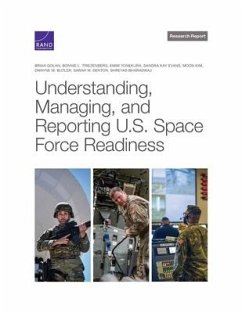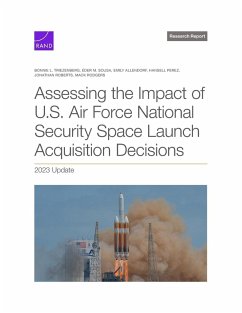
Prompt Global Strikes Through Space

PAYBACK Punkte
8 °P sammeln!
The Air Force and U.S. Space Command have long-range plans to demonstrate the technologies necessary to execute prompt global strikes with precision conventional weapons through space launched from the U.S. homeland to any point on the globe in 90 minutes or less. While the Space Operations Vehicle concept is the postulated delivery vehicle early in the 2010 decade, long-range conventional ballistic missiles could provide an initial capability as early as 2005. In light of the potentially aggressive use of weapons of mass destruction by rogue adversaries in future wars, this paper explores the...
The Air Force and U.S. Space Command have long-range plans to demonstrate the technologies necessary to execute prompt global strikes with precision conventional weapons through space launched from the U.S. homeland to any point on the globe in 90 minutes or less. While the Space Operations Vehicle concept is the postulated delivery vehicle early in the 2010 decade, long-range conventional ballistic missiles could provide an initial capability as early as 2005. In light of the potentially aggressive use of weapons of mass destruction by rogue adversaries in future wars, this paper explores the potential benefits and drawbacks of a capability to conduct prompt global strikes through space with conventional ballistic missiles and the Space Operations Vehicle. Political and military factors involved in the strategic decision to acquire, deploy, and employ such a capability are also examined, with emphasis on the Air Force's role. This work has been selected by scholars as being culturally important, and is part of the knowledge base of civilization as we know it. This work was reproduced from the original artifact, and remains as true to the original work as possible. Therefore, you will see the original copyright references, library stamps (as most of these works have been housed in our most important libraries around the world), and other notations in the work. This work is in the public domain in the United States of America, and possibly other nations. Within the United States, you may freely copy and distribute this work, as no entity (individual or corporate) has a copyright on the body of the work. As a reproduction of a historical artifact, this work may contain missing or blurred pages, poor pictures, errant marks, etc. Scholars believe, and we concur, that this work is important enough to be preserved, reproduced, and made generally available to the public. We appreciate your support of the preservation process, and thank you for being an important part of keeping this knowledge alive and relevant.












